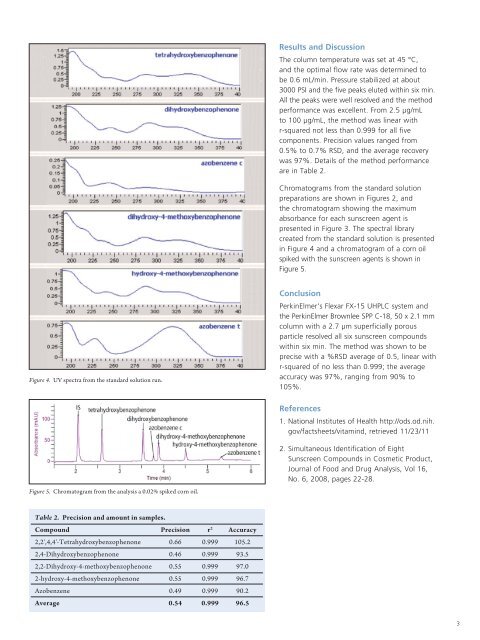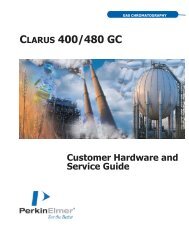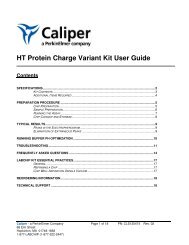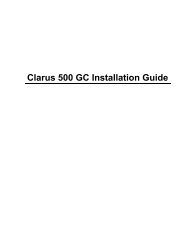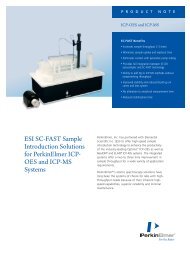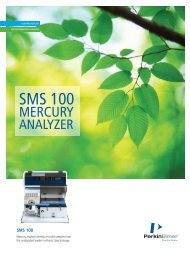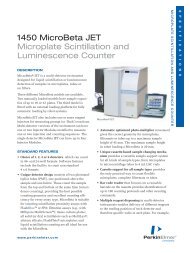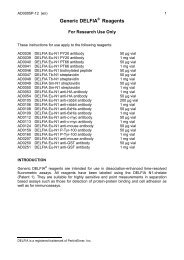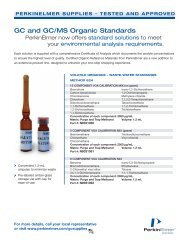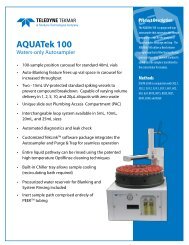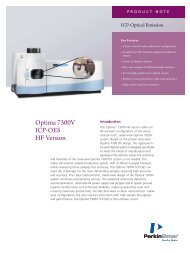Analysis of Sunscreen Agents with the PerkinElmer Flexar FX-15 ...
Analysis of Sunscreen Agents with the PerkinElmer Flexar FX-15 ...
Analysis of Sunscreen Agents with the PerkinElmer Flexar FX-15 ...
Create successful ePaper yourself
Turn your PDF publications into a flip-book with our unique Google optimized e-Paper software.
Results and Discussion<br />
The column temperature was set at 45 °C,<br />
and <strong>the</strong> optimal flow rate was determined to<br />
be 0.6 mL/min. Pressure stabilized at about<br />
3000 PSI and <strong>the</strong> five peaks eluted <strong>with</strong>in six min.<br />
All <strong>the</strong> peaks were well resolved and <strong>the</strong> method<br />
performance was excellent. From 2.5 µg/mL<br />
to 100 µg/mL, <strong>the</strong> method was linear <strong>with</strong><br />
r-squared not less than 0.999 for all five<br />
components. Precision values ranged from<br />
0.5% to 0.7% RSD, and <strong>the</strong> average recovery<br />
was 97%. Details <strong>of</strong> <strong>the</strong> method performance<br />
are in Table 2.<br />
Chromatograms from <strong>the</strong> standard solution<br />
preparations are shown in Figures 2, and<br />
<strong>the</strong> chromatogram showing <strong>the</strong> maximum<br />
absorbance for each sunscreen agent is<br />
presented in Figure 3. The spectral library<br />
created from <strong>the</strong> standard solution is presented<br />
in Figure 4 and a chromatogram <strong>of</strong> a corn oil<br />
spiked <strong>with</strong> <strong>the</strong> sunscreen agents is shown in<br />
Figure 5.<br />
Figure 4. UV spectra from <strong>the</strong> standard solution run.<br />
Conclusion<br />
<strong>PerkinElmer</strong>’s <strong>Flexar</strong> <strong>FX</strong>-<strong>15</strong> UHPLC system and<br />
<strong>the</strong> <strong>PerkinElmer</strong> Brownlee SPP C-18, 50 x 2.1 mm<br />
column <strong>with</strong> a 2.7 µm superficially porous<br />
particle resolved all six sunscreen compounds<br />
<strong>with</strong>in six min. The method was shown to be<br />
precise <strong>with</strong> a %RSD average <strong>of</strong> 0.5, linear <strong>with</strong><br />
r-squared <strong>of</strong> no less than 0.999; <strong>the</strong> average<br />
accuracy was 97%, ranging from 90% to<br />
105%.<br />
References<br />
1. National Institutes <strong>of</strong> Health http://ods.od.nih.<br />
gov/factsheets/vitamind, retrieved 11/23/11<br />
Figure 5. Chromatogram from <strong>the</strong> analysis a 0.02% spiked corn oil.<br />
2. Simultaneous Identification <strong>of</strong> Eight<br />
<strong>Sunscreen</strong> Compounds in Cosmetic Product,<br />
Journal <strong>of</strong> Food and Drug <strong>Analysis</strong>, Vol 16,<br />
No. 6, 2008, pages 22-28.<br />
Table 2. Precision and amount in samples.<br />
Compound Precision r 2 Accuracy<br />
2,2',4,4'-Tetrahydroxybenzophenone 0.66 0.999 105.2<br />
2,4-Dihydroxybenzophenone 0.46 0.999 93.5<br />
2,2-Dihydroxy-4-methoxybenzophenone 0.55 0.999 97.0<br />
2-hydroxy-4-methoxybenzophenone 0.55 0.999 96.7<br />
Azobenzene 0.49 0.999 90.2<br />
Average 0.54 0.999 96.5<br />
3


